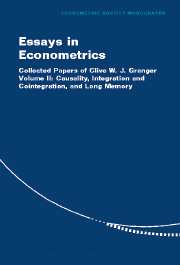Book contents
- Frontmatter
- Contents
- Acknowledgments
- List of Contributors
- Introduction
- PART ONE CAUSALITY
- PART TWO INTEGRATION AND COINTEGRATION
- 5 Spurious Regression in Econometrics
- 6 Some Properties of Time Series Data and Their Use in Econometric Model Specification
- 7 Time Series Analysis of Error Correction Models
- 8 Co-Integration and Error-Correction: Representation, Estimation, and Testing
- 9 Developments in the Study of Cointegrated Economic Variables
- 10 Seasonal Integration and Cointegration
- 11 A Cointegration Analysis of Treasury Bill Yields
- 12 Estimation of Common Long Memory Components in Cointegrated Systems
- 13 Separation in Cointegrated Systems and Persistent-Transitory Decompositions
- 14 Nonlinear Transformations of Integrated Time Series
- 15 Long Memory Series with Attractors
- 16 Further Developments in the Study of Cointegrated Variables
- PART THREE LONG MEMORY
- Index
15 - Long Memory Series with Attractors
Published online by Cambridge University Press: 06 July 2010
- Frontmatter
- Contents
- Acknowledgments
- List of Contributors
- Introduction
- PART ONE CAUSALITY
- PART TWO INTEGRATION AND COINTEGRATION
- 5 Spurious Regression in Econometrics
- 6 Some Properties of Time Series Data and Their Use in Econometric Model Specification
- 7 Time Series Analysis of Error Correction Models
- 8 Co-Integration and Error-Correction: Representation, Estimation, and Testing
- 9 Developments in the Study of Cointegrated Economic Variables
- 10 Seasonal Integration and Cointegration
- 11 A Cointegration Analysis of Treasury Bill Yields
- 12 Estimation of Common Long Memory Components in Cointegrated Systems
- 13 Separation in Cointegrated Systems and Persistent-Transitory Decompositions
- 14 Nonlinear Transformations of Integrated Time Series
- 15 Long Memory Series with Attractors
- 16 Further Developments in the Study of Cointegrated Variables
- PART THREE LONG MEMORY
- Index
Summary
INTRODUCTION
The results presented in this paper can be motivated by considering the prices of some agricultural product, say tomatoes, in two parts of a country, denoted PNt, PSt for the prices in the north and south. At a time t, values of these prices will be a point in the plane with axes PN, PS. In this plane the line PN = PS may be considered to be an attractor because, if two prices are quite different, and thus off this line, there will be market pressure to bring the prices together. If PN is much larger than PS it will be a profitable enterprise to buy tomatoes in the south, transport them to the north and sell them there. This activity will raise demand and thus prices in the south, and raise supply, and thus lower prices, in the north. As the prices becomes near each other, the profitability of this activity will decline and so the strength of the attraction becomes small.
This example illustrates a type of behavior that might be expected to occur frequently in economics. One may have a pair of economic series xt, yt each of which varies over a wide range but plots of xt against yt suggest that the economy has a preference for these points to lie in or near some region which could be called the attractor. This preference may occur through a market mechanism or by the action of government policy, say, when the market is fairly efficient, so that there are no trade barriers for instance, and when the government policy is effective.
- Type
- Chapter
- Information
- Essays in EconometricsCollected Papers of Clive W. J. Granger, pp. 286 - 301Publisher: Cambridge University PressPrint publication year: 2001



